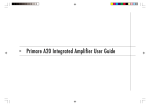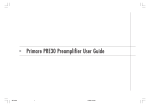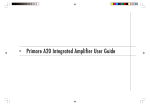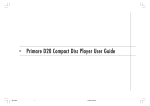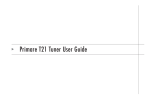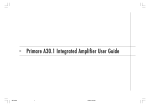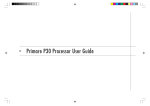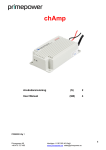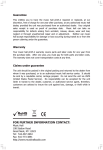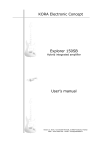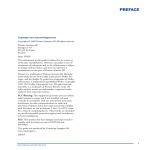Download I20 user manual
Transcript
> Primare I20 Integrated Amplifier User Guide i §0 Preface 1 19/6/02, 10:16 am > Preface COPYRIGHT AND ACKNOWLEDGMENTS Copyright © 2002 Primare Systems AB. All rights reserved. Primare Systems AB Idavägen 17D Warning: To prevent fire or shock hazard, do not expose this unit to rain or moisture. Dangerous voltages inside. Do not open the cabinet. There are no user serviceable parts inside. Repairs should be carried out by qualified service personnel only. SE-352 46 Växjö FCC Warning: This equipment generates and can radiate radio frequency Sweden The information in this guide is believed to be correct as of the date of publication. However, our policy is one of continuous development and so the information is subject to change without notice, and does not represent a commitment on the part of Primare Systems AB. Primare is a trademark of Primare Systems AB. All other product names are trademarks or registered trademarks of their respective owners. energy and if not installed and used correctly in accordance with our instructions may cause interference to radio communications or radio and television reception. It has been type-tested and complies with the limits set out in Subpart J, Part 15 of FCC rules for a Class B computing device. These limits are intended to provide reasonable protection against such interference in home installations. EEC: This product has been designed and type-tested to comply with the limits set out in EN55013 and EN55020. This guide was produced by Human-Computer Interface Ltd. http://www.interface.co.uk ii §0 Preface 2 19/6/02, 10:16 am > Contents Introduction Connecting the I20 Integrated Amplifier W E L C O M E T O T H E I 20 I N T E G R A T E D B A C K P A N E L C O N N E C T I O N S ........................... (7 P O W E R C O N N E C T I O N S ..................................... (8 O U T P U T S ................................................................... (8 I N P U T S ....................................................................... (8 A M P L I F I E R .................................................................. (1 U S I N G T H E I 20 W I T H O T H E R P R I M A R E P R O D U C T S ................................................................ (1 T E C H N I C A L S P E C I F I C A T I O N ............................. (2 Index Using the I20 Integrated Amplifier F R O N T P A N E L C O N T R O L S .................................. (3 F R O N T P A N E L D I S P L A Y ........................................ (4 S W I T C H I N G O N A N D O F F ................................ (4 S E L E C T I N G A S O U R C E ........................................ (5 C H A N G I N G T H E V O L U M E .................................. (5 C H A N G I N G T H E B A L A N C E ................................ (5 iii §0 Preface 3 19/6/02, 10:16 am > Preface iv §0 Preface 4 19/6/02, 10:16 am > Introduction Welcome to the Primare I20 Integrated Amplifier! This chapter introduces you to its key features, and explains how you can take advantage of its superb sound as the key component in your hi-fi system. W E L C O M E T O T H E I 2 0 I N T E G R AT E D A M P L I F I E R The I20 is an integrated preamplifier and power amplifier with extraordinary performance for its price. High-performance power amplifier The I20 incorporates a power amplifier providing 70 Watts per channel of superb quality sound. Superb technical design The I20 incorporates a classic circuit design based on J-FET input devices and bipolar output devices, typical of far more expensive equipment, giving high performance and excellent reliability. Intuitive user interface In keeping with the philosophy of the Primare range of systems, the I20 can be controlled through a very simple and intuitive set of front panel controls. Flexible inputs The I20 preamplifier stage provides four inputs, labelled CD, TUNER, LINE 1, and LINE 2, to cater for a flexible range of sources. Fixed and variable outputs The currently selected source is provided on two pairs of line-level outputs, for Alternatively all the functions of the I20 can be controlled by the C20 Remote Control supplied with the I20, along with the other Primare components in your system. USING THE I20 WITH OTHER PRIMARE PRODUCTS connecting the I20 to other equipment. The TAPE OUT sockets are Although the I20 is flexible enough to work with virtually any other equipment independent of the position of the volume control, and allow you to connect you have in your system, it is ideal for use with the other products in the the I20 to a tape recorder. The PRE OUT sockets are controlled by the volume Primare range, such as the Primare V25 DVD Player, Primare T21 FM Stereo control, and can be used to connect the I20 to another output stage. Tuner, or Primare D20 Integrated CD Player. A particular benefit of using the I20 with other Primare sources is that you can control your entire system with a single remote control, to give you a fully integrated system with the simplest possible user interface. 1 §1 Introduction 1 19/6/02, 10:16 am > Introduction T E C H N I C A L S P E C I F I C AT I O N Output power per channel 2 x 70W into 8Ω, 2 x 110W into 4Ω Speaker terminals 4 –16Ω Output impedance <0.08Ω DC offset <5mV Line inputs 330mV Tape outputs 300mV Frequency response <10Hz – 100kHz, -3dB THD 0.08% (1kHz, 10V into 8Ω) Signal-to-noise, line -98dB (A-weighted) Power consumption, standby <16W Peak current ±20A Dimensions (WxDxH) 430 x 275 x 95mm Weight 11kg 2 §1 Introduction 2 19/6/02, 10:16 am > Using the I20 Integrated Amplifier This chapter explains how to operate the I20 Integrated Amplifier, using either the front panel controls or the remote control. ]A The STANDBY button switches the I20 to standby, or switches it on from F R O N T PA N E L C O N T R O L S standby. All the functions of the I20 Integrated Amplifier can be accessed using the five ]B The input selector buttons select one of the four source inputs. front panel push buttons and volume control, and information about its operation is displayed on the front panel display: ]C The VOLUME control changes the volume. ]A 57 STANDBY VOLUME V CD TUNER LINE 1 LINE 2 I20 INTEGRATED AMPLIFIER ]B ]C 3 §2 Using 3 19/6/02, 10:16 am > Using the I20 Integrated Amplifier F R O N T PA N E L D I S P L AY SWITCHING ON AND OFF The following illustration shows the information on the front panel display: To switch on • Use the switch under the left-hand edge of the front panel. ]A During normal operation you can leave the I20 switched on and in standby. To switch to standby 57 • Press the STANDBY button on the front panel or the STBY button on the remote control. V To switch on from standby • Press the STANDBY button on the front panel. ]B ]A Volume setting. Selecting any function with the remote control will also switch on the I20 from standby. ]B Currently selected input. To dim the front panel display • Press the DIM button on the remote control. The display will dim to show just the currently selected source. To restore the normal display • Press the DIM button again. 4 §2 Using 4 19/6/02, 10:16 am Using the I20 Integrated Amplifier SELECTING A SOURCE The current volume setting is shown on the front panel. The I20 Integrated Amplifier provides a choice of four line inputs, labelled: CD, TUNER, LINE 1, and LINE 2. To select a source • Press the button on the front panel or the remote control corresponding to the source you want to select. The currently selected source is indicated by a V on the front panel display: 23 For example: V • Alternatively, press the A or V buttons on the remote control to step between sources. < For example: 24 V CHANGING THE BALANCE You can change the balance of the sound between the left and right channels to shift the position of the stereo image. To change the balance • Press the [/BAL button on the remote control. The front panel display shows the current balance setting, where -6 corresponds to the leftmost position, 0 corresponds to centre, and 6 corresponds to the rightmost position. CHANGING THE VOLUME For example: The I20 allows you to vary the volume from 0 (silence) to 79 (maximum volume). -2 V • Press the < or > buttons on the remote control to adjust the balance. To change the volume • Rotate the VOLUME control on the front panel, or press the < or > buttons on the remote control. • Press the [/BAL button again to revert to the normal volume display. Alternatively the normal display will revert automatically after four seconds. 5 §2 Using 5 19/6/02, 10:16 am > Using the I20 Integrated Amplifier 6 §2 Using 6 19/6/02, 10:16 am > Connecting the I20 Integrated Amplifier This chapter explains how to connect the I20 to the other components in your system, using the connections on the back panel. B A C K PA N E L C O N N E C T I O N S ]A RIGHT SPEAKER + – ]B ]C GROUND CD TUNER LINE 1 ]D ]A Right loudspeaker outputs. ]D Audio inputs. ]B Ground terminal. ]E Tape outputs. ]C Left loudspeaker outputs ]F Preamplifier outputs. LINE 2 TAPE OUT PRE OUT ]E ]F LEFT SPEAKER – + ]G ]G Mains power input and fuse. 7 §3 Connecting 7 19/6/02, 10:16 am > Connecting the I20 Integrated Amplifier POWER CONNECTION INPUTS Warning: Before connecting power check that the required supply voltage, Source inputs indicated on the back panel, corresponds to your local AC supply. If a Connect each source to the appropriate source input, connecting the right different voltage is stated on the type plate do not connect the amplifier to the channel to the red socket and the left channel to the white socket. mains power, and seek advice from your dealer. Connect the mains power using the enclosed mains cable. Note: Always disconnect the amplifier from the mains power before connecting or disconnecting any of the cables. To connect an analogue turntable with a moving magnet or moving coil cartridge you will need an additional phono preamplifier such as the Primare R20. The output of the turntable is connected to the R20, and the output of the R20 should be connected to a spare input on the I20, such as LINE1. A ground terminal is provided above the input sockets to allow you to provide OUTPUTS a direct ground connection for sources in order to remove hum loops. Loudspeaker outputs Connect the left and right loudspeakers to the corresponding terminals. The terminals can accept speaker cables terminated with 4mm banana plugs, spade terminals, or bare wires. To connect bare wires unscrew the terminal, pass the bare wire through the hole in the terminal bolt, and clamp the wire in place by screwing the terminal back down. Preamplifier outputs The PRE OUT sockets provide a line-level output from the I20 preamplifier stage which can be connected to another preamplifier. The level of this output is controlled by the VOLUME control on the I20. The TAPE OUT sockets provide a fixed level copy of the currently selected source, suitable for connecting to a tape recorder. 8 §3 Connecting 8 19/6/02, 10:16 am > Index A I T audio inputs ....................................... 7, 8 input selector buttons ................................ 3 tape outputs ....................................... 7, 8 audio outputs ..................................... 7, 8 inputs ................................................. 7, 8 technical specification .............................. 2 B L V back panel connections ............................ 7 loudspeaker outputs ............................ 7, 8 volume, changing .................................... 5 balance, changing ................................... 5 C O VOLUME control ...................................... 3 outputs ............................................... 7, 8 connections ............................................. 7 F P power, connecting .................................... 8 front panel preamplifier outputs ............................ 7, 8 controls .............................................. 3 display ............................................... 4 S G source inputs ...................................... 7, 8 ground terminal ....................................... 7 STANDBY button ...................................... 3 source, selecting ...................................... 5 standby, switching on from ....................... 4 9 §4 Index 9 19/6/02, 10:16 am > Index 10 §4 Index 10 19/6/02, 10:16 am














